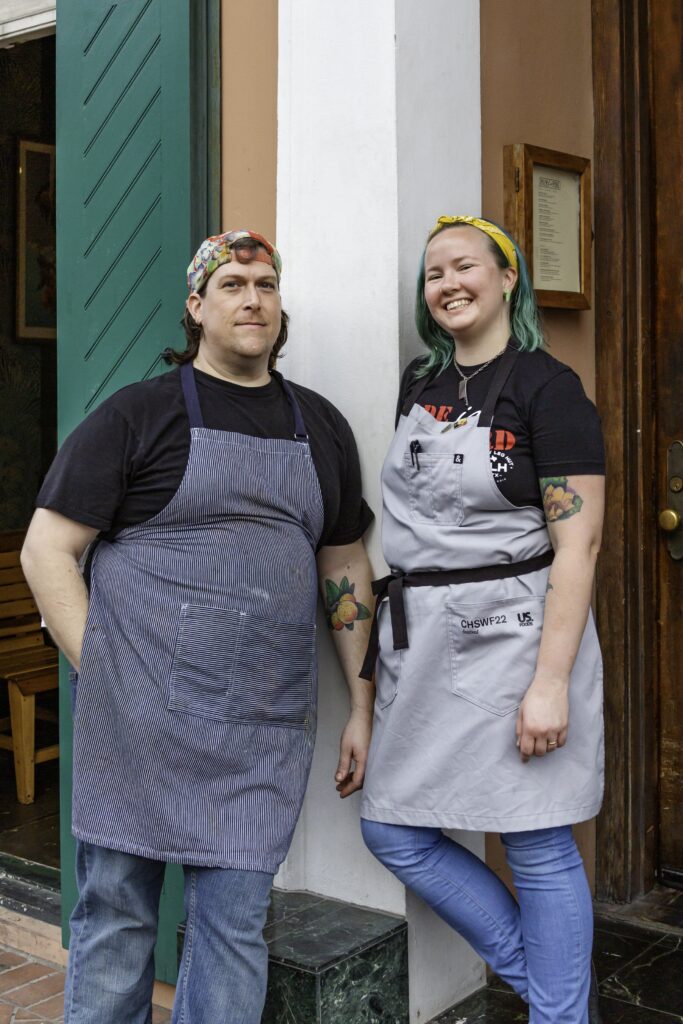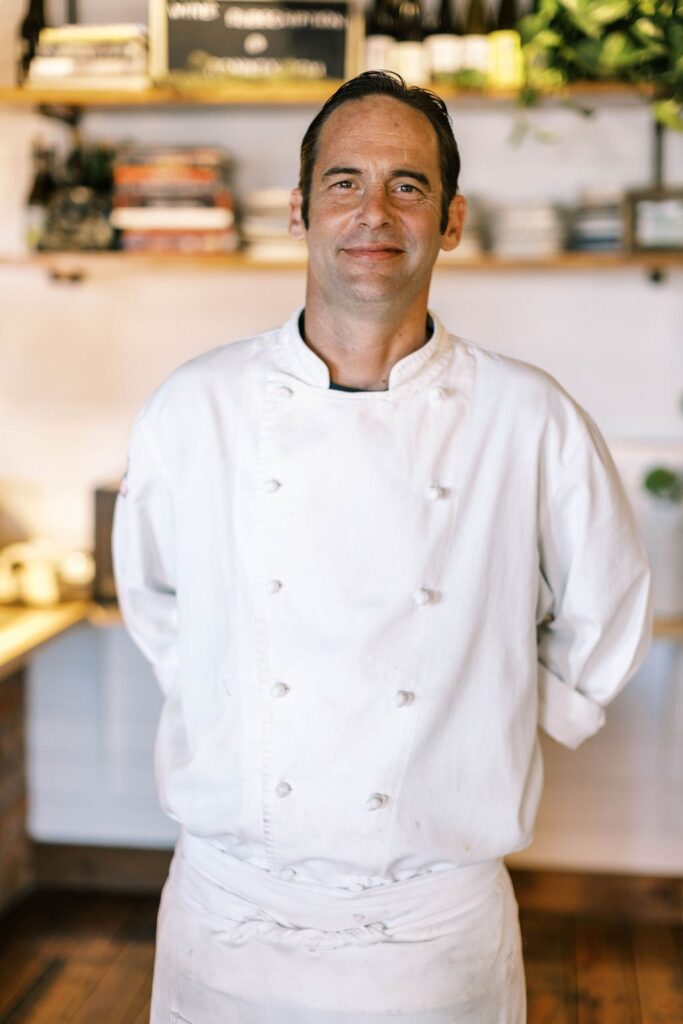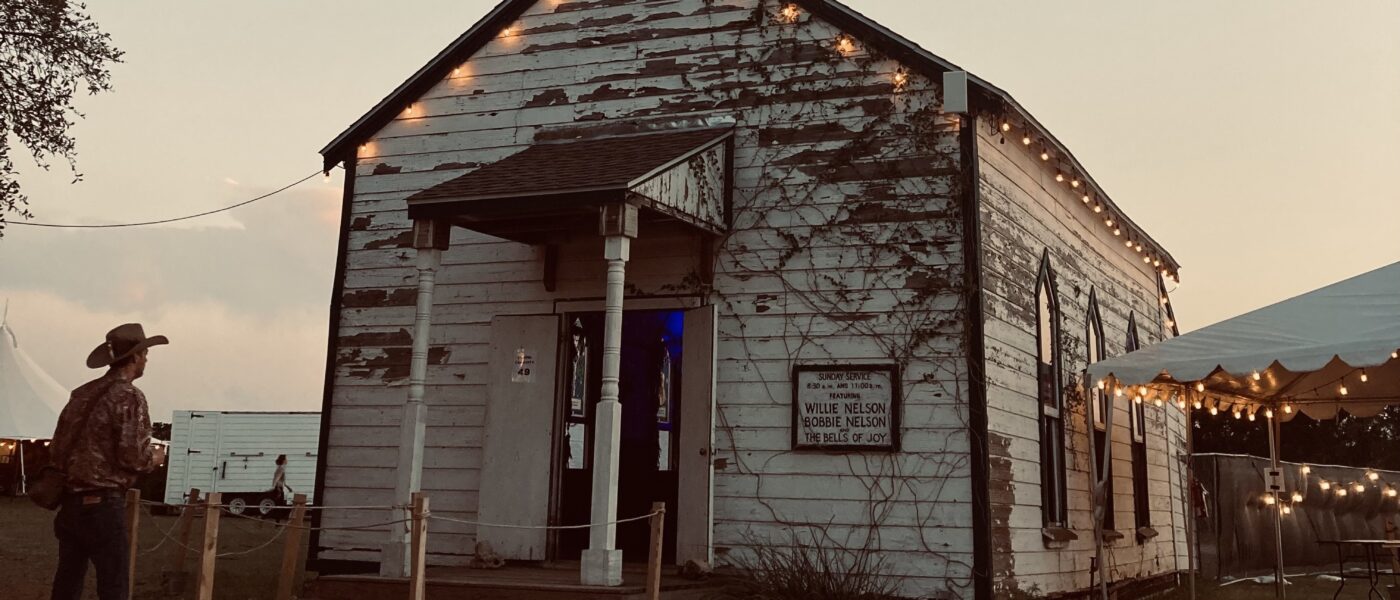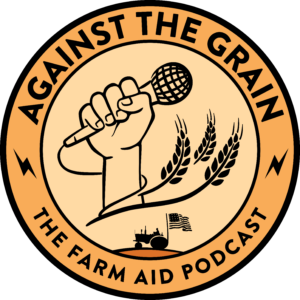Against the Grain is heading back to the Luck Reunion festival, held on Farm Aid president Willie Nelson’s ranch outside of Austin, Texas. The night before the festival, the Luck Family Foundation puts on a PotLuck dinner, bringing chefs from across the country to prepare a regionally-sourced meal that is cooked over an open fire. Proceeds from this dinner benefit Farm Aid and the Texas Food and Wine Alliance. In past podcast episodes, we featured interviews with chefs we met there last year — folks like Rick Bayless, Bleu Adams and Michel Nischan. In this episode, we highlight some of the other chefs we spoke with last year and focus especially on how their work with local farmers builds what Farm Aid calls The Good Food Movement. Check it out!
Listen to the episode below. And, make sure to subscribe in your podcast app of choice!

Chefs Amarys Koenig-Herndon and Jordan Herndon
Amarys Koenig Herndon and Jordan Herndon
Amarys Koenig Herndon grew up in restaurants—her father managed a local Chili’s, and from a young age, she’d help the servers with their side work. Her parents eventually opened their own restaurant, Live Oak Grill, where she was trained in every front of house position. Amarys continued bartending around New Braunfels, Texas, before landing behind the bar at Gruene River Grill alongside Jordan Herndon, her eventual husband and business partner.
Jordan’s East Texas upbringing included Sunday dinners on his grandmothers’ farms, connecting him deeply with the ties between land and food. After meeting Amarys, the couple moved to New Orleans and enrolled in the culinary arts program at Delgado Community College. While in school, Jordan and Amarys cooked at Arnaud’s Restaurant. In 2010, Jordan was hired as a line cook at Ralph’s on the Park while Amarys trained at Bayona under Chef Susan Spicer, both working their way up to sous chef.
Looking to scratch their creative itch, the duo started a pop-up, called The Old Portage (T.O.P.), experimenting with different cuisines and flavors. For five years, T.O.P. continued to grow in popularity until both Amarys and Jordan could make it their full-time jobs. In 2019, following a successful run outside Black Penny, they were able to transform their pop-up into a brick-and-mortar restaurant, Palm&Pine. The Herndons focus their cooking on “The South, and South of that,” drawing influence from New Orleans, the Caribbean, Mexico, and Central America.

Chef BJ Smith
BJ Smith
Chef BJ Smith is a prominent figure in the Pacific Northwest culinary scene, renowned for his expertise in smoked meats and contemporary cuisine. He began his culinary journey at the Western Culinary Institute in Portland, Oregon, and honed his skills at esteemed establishments such as Le Bernardin and Gotham Bar & Grill in New York City, as well as Citrus in Los Angeles.
In Portland, Smith made a significant impact with his Smokehouse restaurant group, which included Delores, Smokehouse 21, Smokehouse Tavern and Kim Jong Smokehouse. He expanded his ventures to Vancouver, Washington, with the opening of Smokehouse Provisions in 2016.
In 2016, Smith showcased his culinary talents on a national stage as a contestant on Season 14 of Bravo’s “Top Chef.”
Smith has also been a featured chef at The James Beard House, Aspen food and wine, pebble beach food and wine, RAW Almond and Star Chefs to name a few.
As of March 2024, Smith serves as the Culinary Director at Oswego Lake Country Club in Lake Oswego, Oregon. He is also a partner at Sit Tite, a dining establishment and bar in Portland.
Throughout his career, Chef BJ Smith has been celebrated for blending classical training with modern techniques, particularly in the realm of contemporary and barbecue cuisine.

Chef Brian Light
Brian Light
Brian Light was born in Venezuela, and was raised between there, Colombia, and Houston, Texas. Both sides of his family are close-knit; he enjoyed many meals at his grandparent’s houses while growing up between the States and South America. While Brian was young, his grandfather used to always say, “every family needs a chef.” With that in his subconscious, Brian began working in restaurants at 16. A graduate of the University of Houston, Hilton College of Hotel & Restaurant Management, Brian then learned to cook by working in distinguished kitchens across America. Aries in Houston, Morimoto in Philadelphia, and Tramonto’s in Chicago all trained him in traditional French and Japanese techniques. After coming to College Station to work at The Republic as the Executive Chef and meeting his wife, they opened Ronin in 2012. On their family farm, he has forged a connection with farming and raising animals. He regularly discusses how farming has informed his cooking on so many levels. Brian strives to bridge the gap between farmers, professional kitchen, and community in creating a fine dining experience with approachable, seasonal food.
Read about Ronin Farm and Restaurant
Check out Palm and Pine restaurant
Learn more about the Luck Reunion
How Chefs and Farmers are Building the Good Food Movement
KURN: Amarys Koenig HerndonHello and welcome back to Against the Grain, the Farm Aid podcast. I’m Jessica Ilyse Kurn.
FOLEY: I’m Michael Stewart Foley. Here at Farm Aid, we’re committed to growing the Good Food Movement. You’ve heard us talk about this before, but just to refresh, the Good Food Movement is an effort Farm Aid works on to help Americans understand where their food comes from and that the food can be raised ethically in a way that’s good for eaters and good for the environment. We found that the more people know about how their food gets to their table, the more invested they become in advocating for farmers, which is maybe more important now than ever in this present political climate.
KURN: And here at Farm Aid we’ve been hearing from farmers and also organizations working with farmers about just how difficult things are at the moment. Government funding freezes, impending tariffs that will impact farmers’ prices and the increasing frequency of climate disasters is that’s just some of the hurdles they’re up against.
FOLEY: This is why making sure the public doesn’t lose sight of who is actually growing our food is so important. The more we can make sure that farmers earn a fair price and that farming is a viable career the more new farmers will get and current farmers will retain.
KURN: Michael, a great way to do this is getting buy-in from chefs. When they feature farms on their menus and farmers’ bounties in their dishes, they’re helping to keep farmers front and center in eaters’ minds. It’s a really good illustration of farm to fork. Last winter, we chatted with movers and shakers in the Good Food Movement when we traveled to Willie Nelson’s ranch outside of Austin, Texas for the Luck Reunion. This small music festival is held in the late winter on the ranch to celebrate American roots music and culture. We’re excited to announce that we’ll be back in Texas at the upcoming Luck Reunion, where we’ll be moderating a panel with artists talking about sustaining community in the face of climate disasters.
FOLEY: And we’ll get another chance to chat with chefs the evening before the music festival as they prepare a fundraising dinner called The PotLuck, which benefits a couple of nonprofit organizations, including Farm Aid.
KURN: You may remember an episode we did with Rick Bayless. We spent time with him and other chefs at Luck Reunion last year, like Chef Michel Nischan and Chef Bleu Adams, who we featured in two other amazing episodes. And just a plug, they’re all available on our website and you don’t want to miss them. After you listen to this episode, head to Farmaid.org/podcast and enjoy those episodes as well.
FOLEY: Now let’s jump in and meet a couple of great chefs who are working hard to form and sustain strong relationships with their local farmers and the greater food community in their cities. Here are Chefs Amarys Koenig Herndon and Jordan Herndon from Palm and Pine in New Orleans.
AMARYS KOENIG HERNDON: Jordan’s at the farmers market at least once a week and they’re all his best friends.
JORDAN HERNDON: Everything revolves around whatever’s going on seasonally, locally, you know, we build dishes around our farmers.
AMARYS KOENIG HERNDON: They’ll hit us up even you know day before and be like “oh I have this cool thing I know you’d be into. Do you want to do a special with it or whatever,” you know?
JORDAN HERNDON: Or “hey I need to move this.” I could say “I don’t need this and or you know it’s like let’s meet in the middle and I’m helping you out and we’re saving some some vegetables.”
AMARYS KOENIG HERNDON: And nothing, yeah, nothing’s getting wasted, um, when we make our orders from like Natco or even our like Louisiana Fresh or like, you know, regular produce that’s coming in from California, like there’s no, there’s not that relationship and give and take, it’s just like either they have it or they don’t either it’s good or it’s not, and there’s no one really accountable for anything beyond. Whether they bring you what you ordered or not, but the quality of it, you know, not really, um, but with with our local farmers it’s a conversation like what are we planting right now? When’s it gonna be ready? How much of it do you think you would use? OK, well this restaurant’s using this and you know I’m gonna have the tops from this. Can you use that for this?
AMARYS KOENIG HERNDON: It becomes kind of collaborative as you build a relationship with the farmers you buy from. In New Orleans we’re all passionate about our city, passionate about our food and I think always there’s been that real sense of community and like supporting each other.
JORDAN HERNDON: I mean it’s not only community but it’s the economy of it too right like it’s just we try to hit up if I’m at the farmers’ market there might be three different vendors with three similar products produce. You know, maybe one week I spend my dollar over here. I can’t maybe spend my dollar everywhere, but you know I can’t hit every single person, but um, you know, like we we get our candles from the market as much many things that we can do to. To keep that dollar in there and then the other thing is we get some farmers come and eat at our restaurant too so that’s always cool.
AMARYS KOENIG HERNDON: And they send people to us too. It just makes sense if you’re not working with your local farmers, then you’re missing out, you know, like it’s a key step in what we do.
FOLEY: You might hear Amarys and Jordan speak and think that the way they work with farmers is unique to New Orleans, but what we’ve found in speaking to chefs is that this kind of collaboration happens all over the country. That same day we caught up with Chef BJ Smith, who runs the Smokehouse Restaurant Group in Portland, Oregon, and is a former contestant on Top Chef. Here BJ talks about the economics of working with farmers.
SMITH: I think that at this point in my career making just making food is kind of, I wouldn’t say the easy part, but it like it’s different, right? Like any career you have and anything you’re passionate about you evolve over the years and I think where I and a lot of my peers are at is just watching all the food where it’s coming from from the beginning to the end is just a really fun part of the process and it brings a lot of inspiration to daily life. Even if we use like a broad liner, produce company that maybe bring stuff in from California or Mexico, which is fine. I mean, you do what you gotta do, right. But people think that getting vegetables from a farm is gonna be so much more expensive and it’s actually cheaper for for us as restaurants buying things wholesale from the farm, it would be cheaper than if we were buying stuff that was brought in from California or Mexico, which makes sense, right? And then there’s no fuel being used and it, I mean, it just makes sense for the trickle down of it is just so awesome.
KURN: One of the things that’s cool about the potluck dinner is that the chefs come from all over the country and cook meals over open fires in the middle of Willie Nelson’s ranch. The menu is determined in a large part by what’s available in mid-March in the region. Last year’s food was primarily sourced from Ronin Farms in Bryan, Texas. Here, BJ Smith, an expert barbecue and smokehouse chef, talks about how he decided to prepare beets as if they were brisket. Yes, you heard that right, beets as brisket.
SMITH: We received a list of everything that they had at Ronin Farms and he said we have a ton of beets and so that just started off right there. And he has beautiful, edible flowers, which will be going on the dish. It kind of is mimicking the same colors. Everything that we have is from Ronin, which they have an incredible restaurant and farm, and we source as much as we could from them outside of olive oil. So I roasted the beets and then punched the beets out in a ring mold and then treated them like their brisket and the smoker and then just brushed like a beet barbecue sauce basically on top of them. Then I made another sauce with some other beet juice and some balsamic vinegar and just really wanted to like touch on the sweetness and the earthiness and add some smoke, you know, it’s really appropriate. I felt like here in Texas, so really just celebrating the humble beet.
FOLEY: Hearing Chef BJ Smith wax lyrical about the humble beet, which we were later lucky enough to sample, so delicious.
KURN: So good!
FOLEY: After hearing from BJ Smith about the importance of his sourcing, we knew that we had to talk to Chef Brian Light, who runs Ronin Farms and Restaurant in Bryan, Texas. He told us that while some of the produce prepared at the PotLuck comes from his farm, he also sources from an organization called Farm to Table Austin, which gathers food from all over the state of Texas. Apples from Lubbock, citrus from the Rio Grande Valley.
KURN: But the most interesting thing I thought was when Brian told us he learned to farm by reading books and watching YouTube videos. It was all a lot of trial and error.
LIGHT: We moved to Bryan and we’re trying to figure out what to do with our life and I said, “well we could buy this house or we could buy this house that has 15 acres. It’s a little further out of town, but for the same price we have 15 acres. Let’s figure it out.” And then we did and then like the first year we grew tomatoes because we had no idea what we were doing and we had this huge bumper crop of tomatoes that if you never had a fresh grown tomato out of your garden, you’ve not had a tomato. It’s amazingly different versus the grocery store, a lot of it’s kind of pale comparisons like I say that they’re like their cardboard that tastes like tomato. So the first year we had a had a kind of a good harvest of tomatoes. The next three years we had terrible harvest because that it was beginner’s luck. And then we just kind of started slowly growing stuff.
So when I started, I had zero expectations of success because I’ve never done it before. So I thought I expected a 100% failure. And so if I got like 10% of something to work, well that was like 100% of that 10% that worked and then you kind of build on your successes and kind of keep going and so like after ten years of doing it, I remember like a lot of it was like books and YouTube and how to figure it all out and then one of the things I read somewhere like how long does it take to set up a farm said 50 years. I was like, alright, well I got a little while to go fair enough. And so every year we get better at it and like we’re kind of getting more and more efficient to see like how few labor hours we can get into this to to still grow what we need to grow but like this year we had had a row of collard greens that was from here to the to the wall basically and maybe as wide as that that door and that fed the restaurant plenty plenty and I was like wow that so it’s kind of incredible to realize that that’s all you really need to feed a restaurant.
FOLEY: The fact that he is self-taught right in the shadow of Texas A&M University, the biggest agricultural school in the state and carved his own path is so interesting and inspiring.
LIGHT: So it’s funny like a lot of the professors and stuff will come by and it’s like, “oh this is a cute little what you doing here, but you’re not gonna feed the world.” Like I guess. And we had this guy we did dinner for, but he was one of the guests and his wife comes up like “is all this organic?” I was like, “I don’t know if it’s organic or not, but it’s all local Texas stuff anyhow.” She’s like, “Well, my husband’s in chemical agriculture, so like we don’t boycott organic, but we generally eat chemicals.” I was like, “Alright, whatever you want.”
And so the guy had the salad that night. He’s like, “Man, I don’t like salad at all. This is the best salad I’ve ever had in my entire life.” I was like that’s interesting because it was grown this way versus what you’re used to buying from, you know, but even that didn’t convince him. I was like, I don’t know what to tell you. So no we’re kind of in the lion’s den over there.
KURN: So many of the chefs we’ve spoken with say they really establish relationships with their local farmers and you can too. A great place to do this is at your local farmers market. I know for one, I’m personally making the goal of getting to know more farmers in my area. So join me. Go to your market, ask farmers questions, buy their food and even consider visiting their farms.
FOLEY: It really helps farmers when you buy directly from them. Having a relationship with your farmer is priceless. You can sign up for a CSA, so you become a shareholder, so to speak, in a farm’s business. CSAs are like a membership to a farm. What’s great about them is that farmers get the money up front. So that they can plan and feel confident heading into a growing season.
And you know personally the farmer who’s growing the food you bring to your table, pretty invaluable. Now is the time to sign up. So check out CSA’s in your region. Go to our website, Farmaid.org/podcast, where we have a link for you to find a local CSA in your area. You just punch in your zip code. And let us know how it goes. What’s the coolest thing you got in your CSA? What new recipes have you tried? We’d love to know.
KURN: And is there something you wish we would have asked the chefs in this episode? Here’s your chance. We’re going back to Luck. Send us an email or drop a comment. You can email us at podcast@farmaid.org and find us on social media, which is @Farmaid on Instagram, Facebook, Threads and now BlueSky.
FOLEY: And don’t forget YouTube, where you can watch almost 40 years of performances and other content. We’re really excited to head back to Luck, we’ll be sure to report back about all of our experiences there. Let your friends know about Against the Grain. We’re beyond grateful when you listen, share, like and subscribe to this podcast.
KURN: Against the Grain was written and produced by us with sound editing by EndHouse Media and direction from Dawn Sorokin. And thanks to Micah Nelson for our awesome theme music.
FOLEY: Thanks so much to all of the chefs who took the time to speak with us and to all of the farmers who provide us with such good food. We’ll chat with you next time.








